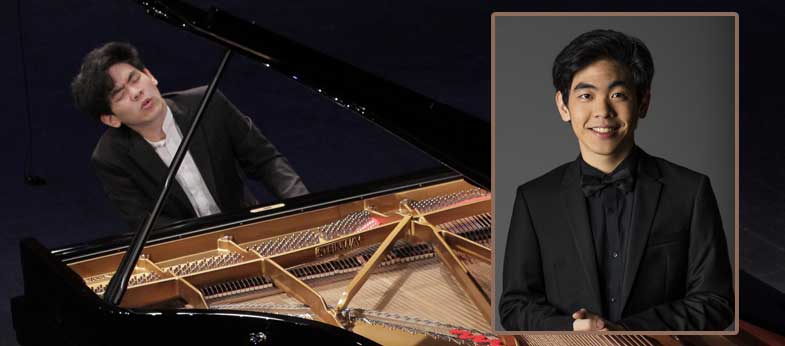
About
A native of the San Francisco Bay area, 19-year-old Daniel Hsu was awarded the Bronze Medal AND two more medals: Best Performance of a New Work and Best Performance of Chamber Music, at the 2017 Cliburn Competition.
Hsu was a Rising Artist for Steinway Society – The Bay Area in 2007, and a year later was accepted, at age 10, to the Curtis Institute of Music, where he is the Richard A. Doran Fellow and studies with Gary Graffman and Eleanor Sokoloff. In 2016 Hsu was named a Gilmore Young Artist and won the bronze medal at the 9th Hamamatsu International Piano Competition. As first-prize winner of the 2015 Concert Artists Guild Victor Elmaleh Competition. Hsu made his Carnegie Hall debut in April 2017.
Daniel Hsu also is a film buff and enjoys computer programming. He contributed to the creation of the Workflow productivity app, which won a 2015 Apple Design Award and has improved the experience of mobile devices for visually impaired users.
Program
Program Notes
Ferruccio Busoni, an Italian pianist and composer, spent thirty years transcribing works of Bach for piano and published them as the Bach-Busoni Editions. The Chaconne is the fifth and final movement of Bach’s Violin Partita No. 2 and has been treated by many composers in transcription, not only for piano (Busoni, Raff, Brahms), but also for cello (Paetsch), organ (Cook, Messerer), guitar (Segovia) and full orchestra (Stokowski). Bach composed the Chaconne sometime between 1718 and 1720. Historians speculate that Bach composed it after returning from a trip and found his wife (and the mother of seven of his children) Maria Barbara had died.
One of the most famous and recognizable works by Chopin, the quite difficult Polonaise in A-flat Major is favored by classical pianists as a showpiece. It is also referred to as the Heroic Polonaise, after the emotional feeling that Chopin’s companion, George Sand, attributed to it. The first theme is a dance, with stately left hand octaves; upon repetition, right-hand trills are subtly added. Chord progressions and arpeggios maintain the high energy as the piece moves between interludes, new themes and the main theme. A march-like melody occurs twice before a lyrical interlude filled with modulation, a slower tempo and interesting harmonies. Before long, the main theme returns in a glorious manner and builds to a short, confident coda derived from it.
The Fantasie was composed in 1841, when Chopin was 31 years old. One of his greatest works, it is composed in a free form and begins with a solemn marching theme that eventually give rise to a passionate, virtuosic section in a triumphant mood. A slow, somber chorale-like section occurs about halfway through the piece before the previous passionate material returns. After a brief, quiet, sweet statement and a final flourish, the piece leaves behind sadness and ends on an uplifting F major chord.
Marc-André Hamelin began playing the piano at age 5 and at age 9 won the top prize in the Canadian Piano Competition. A celebrated composer-concert pianist, he was inducted into the Gramophone Hall of Fame in 2015. This technically challenging piece, commissioned for the 15th Van Cliburn International Piano Competition, was required of all 30 competitors. “‘L’homme armé’ is a song from the French Renaissance,” says Hamelin. “It is the basis for several Masses.” “It is technically demanding, but the way the piece is structured and the way he introduces the theme and builds on it is really interesting,” said Daniel Hsu, the Cliburn bronze medalist who won the special prize for the best performance of this commissioned work.“ It’s an exciting piece. . . All of us had a lot of fun playing it.”
In 1827, a year before his death, Franz Schubert composed a set of eight Impromptus. The first four were published in his lifetime as Op. 90, the last four posthumously as Op. 142. Like his Six Moments Musicaux, these impromptus are great examples of the early 19th-century Romantic genre. Each differs from the next in style and musical traits. The first Impromptu is the longest, a set of variations on two themes. The second Impromptu displays quick scales and offbeat rhythms, while the third requires subtlety and expressiveness to do justice to its lyrical melody. A string of cascading arpeggios in the fourth Impromptu glides the set to a close.